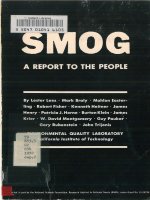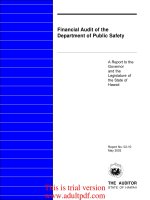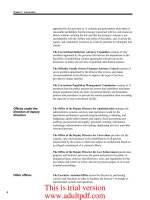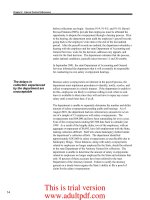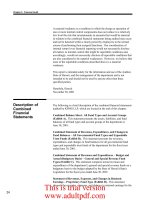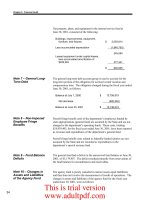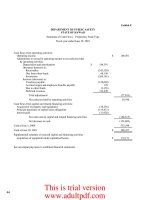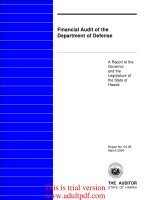Smog - A REPORT TO THE PEOPLE Episode 5 potx
Bạn đang xem bản rút gọn của tài liệu. Xem và tải ngay bản đầy đủ của tài liệu tại đây (710.54 KB, 17 trang )
Tune-ups:
gasoline: 30 x $25
=$750 every 6 weeks
=
$6,500/yr
natural gas: 30 x $25 = $750 every 16 weeks
=
$2,440/yr
LPG:
30 x $25 =$750 every 12 weeks
=
$3,250/yr
Fleet tune-up savings:
$4,060/yr
with natural gas
$3,250/yr
with
LPG
Net savings with natural gas: $1O,920/yr in fuel savings
2,1l0/yr
in
oil savings
4,060/yr
in
tune-up savings
$17,090/yr
total net savings
Net savings with
LPG:
$1,860/yr
in
additional fuel costs
200/yr
storage tank leasing
$2,060/YR TOTAL ADDITIONAL
COSTS
$1,690/yr
in
oil savings
3,250/yr
in
tune-up savings
$4,940/YR
TOTAL
SAVINGS
$2,880/YR
TOTAL
NET
SAVINGS
Payback time:
Natural gas:
$49,900/$17,090
=approximately 3 years
LPG:
$13,750/$2,880
=approximately 5 years
Additional savings possible
in
tax exemptions until 1976:
State tax: 6¢ gallon/LPG, 7¢
unit/CNG
Natural gas: 5,200
units/yr
/truck
at
7¢/unit
=
$364/yr
/truck
=$1O,920/yr
/fleet
LPG:
5,720
gal/yr/truck
at
6¢/gallon
=
$343/yr/truck
=
$1O,300/yr/fleet
Total savings:
$28,000/yr
with natural gas
$13,200/yr
with
LPG
These additional savings greatly reduce the payback time.
Payback time: Natural gas -
1-3/4
years
LPG
- 1 year
The economics of each fleet vary greatly and must
be
investigated
on
an
individual basis. This
is
an example in which the economics definitely favor
conversion.
70
TABLE
9
Example
2.
CONVERSION
OF
FLEET
OF
8
SEDANS
AND
18
TRUCKS
Cost of Fuels/Gallon
gasoline 26¢ regular
propane
14'h¢
+4¢ federal tax
32¢ ethyl
compressed natural gas
5.5¢/100
cu. ft.
1.0¢/100
cu. ft. compression and servicecost
6.5¢/100
cu. ft.
(there is nofederal fuel tax
on
compressed natural gas)
State tax exemptions for both propane and natural gas have been included
Cost
of
FuelIYear
gasoline
21,280 gallons 28.8¢ (avg.)
year
x gallon =
6130/year
propane
25,500 gallons 18.5¢ - $4720
year
x gallon -
/year
natural gas
2,128,000 cu.
ft. x 6.5¢ _ $
year 100 cu. ft. - 1382
please note
that
100 cu. ft. natural gas = 1gallon ofgasoline and that 1.2gallons
of propane
= 1 gallon of gasoline
Cost
of
Routine Maintenance/Year
(Oil changes and tune ups)
gasoline $1688
propane
1/3
x 1688 = $563
natural gas 113
x 1688 = $563
Total
Fuel
and Maintenance Cost/Year
gasoline
propane
natural gas
6130
+1688
$7818
4720
+ 563
$5283
1382
+ 563
$1945
fuel
routine maintenance
total
cost/year
fuel
routine maintenance
total
fuel
routine maintenance
total
71
Savi
ngs/Year
propane
cost
on
gasoline
cost
on
propane
saving
7818
5283
$2535
We
estimate that
if
natural gas were used, approximately
80%
of
the driving would
be
done
on
natural
gas
and the remaining
20%
would
be
done
on
gasoline.
cost
on
dual fuel (natural
gas
and gasoline)
.2
x 7818 + .8 x 1945 =$3120
natural
gas
cost
on
gasoline
cost
on
dual fuel
saving
7818
3120
$4698
Cost
of Converting to Propane
8 sedans at $525/sedan
18 trucks at
$450/truck
storage tank installation
4,200
8,100
1,000 estimate
$13,300
23,066
1,000
$24,066 total
=5.25 years
Cost
of Converting to Compressed Natural
Gas
cost of conversion and
refueling equipment
installation cost (est.)
Simple Equipment Payoff Times
propane $13,300 total cost
$2535 net saving/year
natural
gas
$24,066 total cost
: '-:-, : ' ' ' ' ' = 5.12
yea
rs
4698 net saving/year
(Note that if the use of gasoline rises to
30%
the payoff time becomes
5.7 years.)
An
additional economic benefit
not
taken
into account
is
the extended
engine lifetimes for gaseous fueled vehicles. Fleet operators currently using
gaseous fuels report
that
the lifetime
of
engines (time between overhauls)
is
extended by 50%
to
100% over the average engine lifetime burning gasoline.
11/3.3 Gaseous Fueled Vehicles: Safety and Insurance
11/3.3.1 Safety
Gaseous fuel systems have a number
of
qualities
that
make them inherently
sale for use in motor vehicles. Gaseous fuel tanks are constructed of heavy
boiler plate steel, since they are pressure tanks. They have more
than
twenty
times the resistance
of
ordinary gasoline
or
diesel tanks in a collision. Gas-
eous fuel tanks are fitted with strong valves
and
fittings which are recessed
72
for added safety and which contain shutoff valves
that
operate automatically
in the event
of
a fuel line
or
valve break.
12
Nearly twenty years ago
an
Interstate Commerce Commission report stated:
"It
would
appear
from examination
of
accident records
that
liquefied petroleum gas equipment
is
practically never involved
in a fire accident because of failure
or
rupture
of
the fuel system.
This increased safety may be attributed
to the necessarily
sturdy construction
of
butane and propane tanks."13
Gaseous fuel systems must meet exacting standards. Conversion equip-
ment must
be
of
a type tested and approved by the California State Air
Resources Board.
14
Gaseous fuel tanks must meet standards set by the
Department
of
Transportation (D.O.T.)15
or
the American Society
of
Mechanical Engineers (A.S.M.E.).16 The tanks must be reinsyected and
certified every five years
or
whenever they are repaired
or
installed.
A U.S. Department
of
Commerce report recently pinpointed the principal
drawback
of
gaseous fuels:
"From
a fire and explosion safety standpoint, leakage
is
more
of
a problem with gaseous
than
liquid fuels. With proper
equipment and handling,
LPG
presents no undue hazards, but
if used by the general public, vehicle engineering and mainten-
ance would have to
be
more severe
than
has been the practice
with liquid fuels. Experience with
LPG
fueled vehicles indi-
cates
that
this
is
possible."17
Gas leaks in enclosed spaces are the principal fire hazard associated with
gaseous fuels. When natural gas
is
leaked into the open atmosphere, it will
rise
and dissipate harmlessly. Gasoline "puddles" on the ground
and
presents
a potential fire hazard.
LPG
descends
to
the ground and dissipates as
vapor
unless it is confined.
In
closed buildings,
LPG
flows down to the lowest
levels when spilled, creeping through ventilators and cracks to the lowest
level
of
the building. Since many buildings have furnaces
in
the basement,
an
LPG
spill presents the same fire and explosion hazard as a gasoline spill
l2"Safety Factors in Operating LP-Gas Engines," National LP-Gas Association Times,
Spring 1970, pp. 25-26.
"Motor
Carrier Fire Accidents, 1951,
ICC
Bureau
of
Motor
Carriers, Section
of
Safety
(December
14, 1953) p. 38.
I4Cal.
Health
and
Safety Code, Sections 39110-14 (1970).
"49
CFR
173.34 (1971).
16ASME Boiler
and
Pressure Vessel Code (1968). Proposed Regulations
of
the Department
of
the California Highway Patrol, Fuel containers
andfuel
system
for
compressed natural
gas,
lique-
fied
natural gas
and
liquefied petroleum gas (1971); National Fire Protection Association Stand-
ard
No. 58; Liquefied Petroleum
Gas
Safe Handling
and
Use,
American Insurance Association
(1965).
"The
Automobile and
Air
Pollution: A Program
for
Progress, U.S.
Department
of
Commerce,
December,
1967,
Part
II, p. 47.
73
in a building which
is
not
adequately ventilated for the purpose
of
dissipating
heavy vapors. Both
LPG
and
CNG
contain odorizers which reveal the
presence of gas in the event of a leak. The odorizer condenses
out
of
natural
gas
during
liquefaction,
however.
An
LNG
leak
would
not
be
evident
because
the revaporized gas
is
almost pure methane
and
therefore odorless. New
odorizers are being developed
to
remedy the problem.
Gaseous fuels have higher ignition temperatures
than
gasoline, so it
requires a hotter spark to ignite them. Gasoline ignites
at
600°-700°
F,
compared to 870° F for
LPG
and
1,300° F for natural gas. The burning range
of
LP
gas
is
narrower
than
that
of
gasoline. Natural gas has a somewhat
wider burning range,
but
it dissipates into the atmosphere very rapidly, while
gasoline puddles
and
slowly vaporizes.
On
the whole, gaseous fuels pose no
greater fire and explosion hazard
than
gasoline. R. H. Eshelman, Detroit
Technical Editor for
Automotive
Industries, recently wrote, "Evidence from
many fleet type operations to date suggest
LPG
fuel systems may prove as
safe
or
safer than conventional ones."18
Experience with gaseous fueled vehicles indicates
that
they are
at
least as
safe as vehicles burning gasoline. General Telephone Company
of
Florida
has been using gaseous fuels in its 1,850-vehicle fleet since 1964. Mr. Gary
Powell, General
Plant
Administrator for Transportation, wrote,
"I
feel as
far as
LP
gas being safe, it
is
much safer than gasoline,
if
used in the correct
way. With the extra thickness
of
the
tank
and the electric lock off, it makes
LP
gas'much safer to use as
motor
fuel
than
gasoline." The Chicago Transit
Authority (CT
A)
has run
LP
gas-fueled buses 716 million miles without ever
suffering damage of significance to the
LP
gas-fuel systems as a result
of
traffic accidents. Some fueling accidents resulted in fire losses,
but
according
to Mr. Stanley D. Forsyth, former
CT
A general superintendent
of
engineer-
ing, "There have been a few small fires in the engine compartments during
this six-year period,
but
the loss per mile
of
operation due to all causes is
lower with
LP
gas
than
with the other two standard fuels (diesel
and
gasoline).
"19
The General Services Administration (GSA) recently tested a fleet
of
dual-fuel vehicles burning either gasoline
or
natural gas. The
GSA
report
said:
"The first year's experience with these dual-fuel vehicles has
resulted in an enviable safety record. None
of
the
data
studies
or
the people consulted indicates any safety problem when
these vehicles were used under normal conditions
"The
GSA
test fleet record shows no fires, injuries
or
hazardous incidents
"Studies have indicated
that
methane systems should be
appreciably safer
than
gasoline in accident situations. The
tankage
is
considerably more rugged, the maximum leak
or
18Eshelman,
"LP
Gas Conversion," Automotive
Industries,
May
15,
1970,
p.
60.
19"Safety
Factors in Operating LP Gas Engines," op. cit., p.
26.
74
fire
is
greatly reduced and spillage due to overturning
is
not
possible.
"20
The cities
of
Los Angeles
and
San
Francisco have promulgated stringent
regulations for parking
LP
gas-powered vehicles inside
of
buildings. Under
Los Angeles Fire Protection Bureau Requirement No. 35, inside storage
of
liquefied flammable gas (LFG)-powered vehicles "may
be
permitted in areas
designated by the Fire Department. No vehicle shall
be
stored, parked
or
maintained in any building occupied
or
used as
an
Institutional
or
Assemblage
Occupancy." Under the
San
Francisco Fire Code,
an
LP
gas-powered vehicle
cannot be parked
or
stored in any building except a building used exclusively
for storing, parking
or
repairing. The vehicle
is
not
permitted below the grade
level, and buildings used
to
house them shall have
no
basement
or
open
area below grade level. In
San
Francisco a vehicle powered by
LPG
cannot
be parked on the premises outside
of
buildings except
in
approved locations.
Although such stringent regulations appear to be unreasonable in view
of
the
safety record of gaseous fuels, it is wise for the fleet owner contemplating
conversion to
be
thoroughly familiar with fire regulations in his operating
area and follow them to the letter until they are changed.
Mr. R.
L. Davis, Assistant Manager for Regional Loss Control, Insurance
Company
of
North America, stresses the fact
that
gaseous fuel system instal-
lations must meet all applicable codes and safety standards
if
they are to
be
safely used. Statistics gathered by the National Fire Protection Associa-
tion over
30
years showed
18
accidents where
LP
gas as
an
engine fuel was
involved.
In
every case the cause
of
the accident was traced to noncompliance
with national standards.
21
Gaseous fuels, then, are safe
to
use as
motor
fuel
when used in state certified systems which are installed and maintained
by
competent personnel in accordance with all applicable codes and safety
standards.
11/3.3.2
Insurance
The insurance industry does not recognize any distinction between gaseous
fueled vehicles and gasoline powered vehicles in its rate structure. Mr. William
G.
Meade, Director
of
the Environmental Sciences Unit for the Hartford
Insurance Group, recently wrote:
"There
is
no difference
in
premium between an
LP
gas-powered
or
gasoline-powered vehicle or, for
that
matter, a diesel-
powered vehicle. The rates and premiums are based
upon
many
2°A
Report
on
the General Services Administration's Dual-Fuel Vehicle Experiments: Pollu-
tion
Reduction
with Cost SaVings, General
Services
Administration.
Washington,
D.C.:
U.S.
Government Printing Office
(1971),
p.
17.
21"Safety
Factors in Operating LP-Gas Engines," op. cit.,
p.
25.
75
factors, including use, locations, etc.,
but
the fuel
is
not
one
of
the criteria.
"22
Insurance underwriters insist
that
conversions meet applicable state
and
local
standards
if
they
are
to
insure
a
vehicle.
One
standard
often
referred
to
is
"National Fire Protection Association Standard No. 58, Storage
and
Handling
of
Liquefied Petroleum Gases,
1969."23
The Uniform Fire Code,
County of Los Angeles,
and
the Pacific Fire Rating Bureau, a commercial
rating organization for the insurance industry,
both
require
that
vehicles con-
verted to gaseous fuels comply with
NFPA
standard No. 58. The Los Angeles
City Fire Department specifies strict standards
that
must be met by gaseous
fuel conversions in the
city.24
The State
of
California requires
that
the con-
version use a system approved
by
the California State Air Resources Board
and
use tanks which meet D.O.T.
or
A.S.M.E. standards.
25
The insurance industry does distinguish between gaseous fuels
and
gasoline in refueling installations
and
structures in which vehicles are stored.
Both underwriting and price distinctions may be made, depending
on
the
nature and location of facilities. The
Underwriting Manual
of
the National
Bureau
of
Casualty Underwriters, 1971, establishes a higher basic bodily
injury rate for
LPG
fueling stations
than
for gasoline stations. The basic
property damage rate
is
the same. No rate has been established for natural
gas fueling stations, but analogous rates
for
natural gas are higher than for
either propane
or
gasoline. Rates vary, however, depending
on
facilities,
safety record,
and
types
of
coverage sought. Anyone contemplating the
installation
of
gaseous fueling facilities should contact his insurance com-
pany to determine whether
or
not
his insurance cost will change.
Insurance companies may determine
that
gaseous fuels are safer
than
gasoline for many uses. When Disneyland converted some
of
its boats to
burn
natural gas, its insurance underwriters determined:
"This fueling system should eliminate many of the exposures
that exist with the present gasoline fueling system
and
should
present no unusual operating problem
or
excessive exposure
to employees
or
guests."26
22The
conclusion that no rate differential exists between gaseous fueled and gasoline fueled
vehicles was supported
by:
Mr.
Hubbard
of the Insurance Services Office, a licensed rating organi-
zation, telephone conversation
of
September
16,
1971; Mr.
John
J. Bailey, Fleet Safety Coordi-
nator, American Insurance Association, letter dated
June
9, 1971; Mr. Paul E. Lippold, Public
Affairs Manager, Allstate Insurance Company, letter dated
June
7,
1971; Mr. Gerold L. Maatman,
Vice President, Lumbermens Mutual Casualty Company, letter dated
June
18,
1971; and
Mr. R.
L. Davis, Assistant Manager for Loss Control, Insurance Company
of
North
America,
letter dated June 9, 1971.
23NFPA No. 58. Copies are available from the National Fire Protection Association, 60 Battery-
march Street, Boston, Massachusetts,
02ll0.
24Los
Angeles Fire Department Requirements for Liquified Flammable Gas Powered-Internal
Combustion Engines, Fire Prevention Bureau Requirement No. 35, 5-17-71(rev.). Los Angeles
City Fire Code, sections 57.44.39,
57.44.40 (1971).
"California Administrative Code, Title
8,
pp. 451-550, Unified Pressure Vessel Safety Orders.
26Mr.
R. L. Davis, Assistant Manager Regional Loss Control, Insurance Company
of
North
America, letter
of
March
12,
1970.
76
Gaseous fuels are safe and easy to insure if they are installed and used in
strict compliance with all applicable standards and maintained by
qualified,
repairmen. Failure to use certified pressure vessels
or
conversion systems
on gaseous fueled vehicles will increase the potential for accidents and make
it difficult
to
insure vehicle fleets and terminal facilities.
11/3.4 Feasibility and
Costs
of
Exhaust and Evaporative
Emissions Control Devices for Used Cars
11/3.4.1 Vacuum Spark Advance Disconnect (VSAD)
The vacuum spark advance disconnect interrupts the normal vacuum signals
applied to the distributor from the carburetor. The principal effect
is
that
ignition occurs later in the engine cycle so that peak temperatures and pres-
sures are reduced, thus leading to a lower rate
of
formation of oxides of
nitrogen. This improvement
is
especially significant for 1966-1970 vehicles
becaus'e
of
their high NO
x
emissions (Section I1/2.3, Table 4).
Figure
33
illustrates a typical VSAD installation. Normally the vacuum
line runs directly from the carburetor to the distributor. However, in the
retrofit device a thermostatic (overtemperature) switch
is
placed in the
vacuum line, interrupting the normal vacuum signal when the switch
is
open.
The switch
is
connected into the coolant return line (upper radiator hose) so
that
it can sense if the engine
is
overheating and reconnect the advance.
Many vehicles will operate satisfactorily without the overtemperature
switch if the advance line
is
merely disconnected and plugged. Undergrad-
uates in the Clean Air Car Project
of
the
EQL
are investigating the operating
characteristics
of
pre-I970 gasoline powered cars subjected to the "Clean
Air Tune-up." This procedure consists
of
the following elements:
1.
Test
of
the cooling system
to
insure
that
it
is
functioning properly;
2.
Testing and tuning
of
fuel and electrical systems;
3.
Disconnecting the vacuum spark advance;
4.
Tuning for idle engine rpm
of
600 in "drive" for vehicles with automatic
shift and 700 for vehicles with manual shift
at
lean "best idle" (normally
at
14:1
air-fuel ratio).
This procedure
is
the same as
that
proposed by General Motors, except
that
the thermal vacuum switch which reconnects the vacuum advance
at
engine temperatures above 205°F
is
not included. Preliminary results give
the following percentage reductions in exhaust emissions for pre-1966 cars:
HC
41%
CO
32%
NO
x
32%
Estimated cost
is
$10-15, including the "tune-up," as compared with a mini-
mum
e~tim~ted
ccst
()f
the
VSAD
;Uustrated
~n
P~gure
~~
of
$20
without the
tune-up.
77
As
noted in
Part
I, legislation passed in
1971
requires
that
beginning in
1973
all 1966-1970 cars must be equipped with a device
that
will "signifi-
cantly" cut nitrogen oxide emissions. The certification
that
such a device
is
installed
on
the car
is
to be made
on
initial registration,
or
transfer
of
ownership, or on renewal
of
registration. A limit
of
$35
is
set on the initial
cost
of
such a device, including installation charges, and the device must not
require maintenance more often
than
once every 12,000 miles
at
a maximum
cost
of
$15. The State ARB recently set the standards for such a device
or
control measure. These standards require a 30% decrease in
NO
x
emissions
for engines with a displacement greater
than
140
cubic inches,
and
a 20%
reduction in
NO
x
emissions for engines under
140
cubic inches displace-
ment. Emissions are to be measured by the constant volume sampling (CYS)
7-mode cycle, with a
60
mph cruise mode included.
The
motor
vehicle population in the
South
Coast Air Basin
is
projected
at
6.3 million in 1975, and 35%
of
these vehicles will be 1966-1970 models
(Appendix),
or
about 2.2 million vehicles.
If
retrofit
of
these vehicles
is
com-
pleted by the end
of
1975, the estimated cost
of
the
YSAD
itself
is
about
45
million dollars and the estimated maintenance cost
is
about
30
million
dollars,
or
a total
of
75
million dollars.
If
the procedure recommended by the
Clean Air Car Project
is
adopted, the cost
of
the disconnect plus "tune-up"
is
about
33
million dollars. Additional yearly "tune-ups"
at
a cost
of
about
22 million dollars per year for the 1966-1970 cars would probably be required
anyway as
part
of a mandatory annual vehicle emissions inspection system
for all vehicles.
In
any case these costs will be borne by the motorists. (See
Section
I1/5.3
on
emissions taxes.)
11/3.4.2 Capacitor Discharge Ignition Optimization
System
This system was developed by Air Quality Products, Inc.,
to
meet the
emissions standards for 1955-1965 model used car devices set forth in the
Health and Safety Code, Sections 39107
and
39175 to
39184.21
It
was
accredited by the ARB on September
15,
1971, in Resolution 71-72. At
that
time the board had some reservations
about
the device,
but
on
December
17,
1971, the ARB adopted Resolution 71-72A, removing all reservations except
that the applicant
is
required to submit manufacturing and marketing plans
prior to action by the ARB making the device mandatory for 1955-1965
vehicles.
The system installation, shown in Figure 34, involves certain adjustments
of
the internal programming
of
the system to fit the characteristics
of
each
particular vehicle. In addition, the carburetor
is
set for
an
idle speed
of
50-75
rpm
over normal manufacturer's specification and for lean idle mixture
(1.5% CO in the exhaust).
27
Also Title
13
of
CaliforniaAdministrative Code,
Chapter
3, Sub-chapter
2,
Parts
2
and
3.
78
The ignition optimization system retards the spark under certain conditions
by interrupting the vacuum advance signal via a solenoid-activated switch
and/
or electronically delaying the spark. This measure lowers peak pressures
and temperatures in the combustion process
and
reduces NO
x
emissions.
However, some reduction in hydrocarbon emissions also occurs. The best
explanation
of
this phenomenon
is
that
combustion probably continues to
take place right into
part
of
the exhaust cycle
of
the engine,
and
some resid-
ual
HC
is
burned as it
is
swept
out
of
the cylinder.
Additional hydrocarbon emissions reduction results from the "leaning
out"
of
the carburetor away from the normally "rich" setting found in the
older vehicles. The slight increase in NO
x
that
usually accompanies this
change
is
more
than
compensated for by the timing changes.
ARB data obtained during accreditation testing shows that
an
average
reduction of 60-70% in hydrocarbons
and
30-40% reduction in
NO
x
is
pos-
sible in pre-1966 vehicles. Except for a slightly larger reduction
in
HC
emis-
sions, this performance
is
about
the same as for the simpler YSAD.
This system would also be applicable to 1966-1970 vehicles. These cars
have already been tuned "lean" to meet hydrocarbon
and
carbon monoxide
emissions standards,
but
they tend to emit high levels of oxides
of
nitrogen.
The manufacturer claims
that
a 50-60% reduction in
NO
x
and
10-15%
reduction in
HC
are possible
on
these vehicles. This performance
is
also
about
the same as for the simpler YSAD.
At present the installed cost
of
this system
is
claimed to be $40, as com-
pared to a maximum allowable price
of
$85.
28
By
1975,
about
12% of the
vehicles would be in the pre-1966 category,
or
about
760,000 vehicles in the
South Coast Air Basin. At the estimated price
of
$40 the cost
of
the retrofit
would be about
30
million dollars in the
South
Coast Air Basin.
11/3.4.3 Evaporative Control Retrofit
Evaporative losses
of
gasoline in pre-1970 vehicles without evaporative
control systems are as follows:
1.
Breathing losses from the fuel
tank
and
other parts
of
the fuel system
because
of
diurnal heating
and
cooling;
2.
Running losses from
the
fuel
tank
and
carburetor vents during operation;
3.
Evaporation of the fuel from the heated carburetor
and
other parts
of
the
fuel system during
"hot
soak" after the engine
is
turned off.
The evaporative control standard for 1970-1972 vehicles limits the total
evaporative emissions to 6 gms
of
hydrocarbons under a test procedure simu-
lating one diurnal cycle
and
a 21-minute trip with the associated
"hot
soak."
28Unti1
1971
the maximum allowable cost was $65, but legislation passed in
1971
raised this
limit to
$85.
79
After 1972 the limit
is
2 gms per test.
29
Uncontrolled vehicles typically show
20-60 gms per test. Controlled vehicles seem
to
be able
to
meet the standard
easily,
and
the test results are often reported as "zero."30 A considerable
number
of
techniques are used in evaporative control systems.
Many
are
applicable
to
retrofit systems.
Carburetor losses in operation
and
during
"hot
soak" are controlled in
several ways. External vents for the carburetor float bowl
and
other chambers
are either eliminated, made internal (so the vapors are consumed by the
engine), or manifolded
to
a vapor storage system such as a
carbon
canister
or the engine crankcase.
Fuel
tank
losses are controlled by collecting the emitted vapors in either
a carbon canister
or
the engine crankcase, after separation from the liquid
gasoline via a suitable standpipe system. Losses occurring during engine
operation are drawn into the engine via the air induction
to
the carburetor
and/
or
the positive crankcase ventilation (PCV) system.
The
diurnal
and
"hot
soak" losses are stored in the vapor collection system, which
is
purged
with outside air when the vehicle
is
started. The contaminated purge air
is
drawn into the engine via the carburetor
or
the
PCV
system.
A typical system utilizing a
carbon
canister for storage
is
illustrated in
Figure 35. The canister stores
both
fuel
tank
and
carburetor losses when the
engine
is
not
operating. Purge
is
accomplished via the
PCV
system.
The cost
of
the evaporative control retrofit
is
currently estimated as high
as $150. Probably the vehicle fuel
tank
would have
to
be removed
and
either
modified
or
replaced. Installation
of
the other components under the
hood
would have
to
be made, along with the necessary connections
to
the engine
and/
or carburetor. The problem
is
complicated by the large variety
of
vehicle
makes
and
models, so
that
specialized components are required. However,
all the pertinent technology exists.
What
remains
is
the design
and
testing
of
the suitable systems. Studies
of
simpler, less expensive systems are in pro-
gress as
part
of
the EQL Clean Air
Car
Project.
By
1975,
3.8%
of the vehicle population will be pre-1970 vehicles with no
evaporative controls. The 1966-1969 vehicles will represent 25%
of
the popu-
lation. Assuming
that
evaporative control systems reduce losses by 90%, all
1966-69 vehicles would have
to
be retrofitted
to
achieve the 50% reduction
in evaporative losses projected in the EQL strategy. The cost
of
this retrofit
would be 230 million dollars for the
South
Coast Air Basin.
Such
an
expensive retrofit will almost certainly require some cost-sharing
between the motorist
and
the general public. In general these devices will
be installed
on
older vehicles having lower registration fees, so registration
fee deductions would be a poor method
of
compensation. State income
tax
write-offs are a possible method,
but
most likely a straight cash subsidy
of
part
of
the retrofit cost will be required. The State will have to find
an
appro-
"California Fuel Evaporative Emission Standard and Test Procedure for
1970
Model Gasoline
Powered Vehicles Under
6,001
Pounds Gross
Weight~ARB-as
Amended March
19,
1969.
JOSarto,
J.
0.,
et ai, Chrysler Evaporation Control System,
The
Vapor Saver,
1970
SAE Paper
700150.
80
priate revenue source, such
as
emissions taxes, to finance this control measure
(Section 11/5.3).
If
a partial or total subsidy were to be paid
to
vehicle owners for installation
of
an evaporative control device on 1966-1969 vehicles, an equal subsidy
ought
to
be made available
to
vehicle owners who take any other step that
would reduce hydrocarbon emissions by a comparable amount. Two examples
are:
1.
"Junking"
of
the vehicle and purchase of a post-1969 vehicle;
2.
Sale of vehicle to a new owner who lives and works outside the Basin and
purchase of a post-1969 vehicle. (See also Section 11/5.4 for discussion
of "export" subsidy.)
81
82
Emissions from stationary sources are
not
the major reason for the
poor
quality
of
air in the
South
Coast Air Basin today
but
neither are they negli-
gible. With 35%
of
nitrogen oxides
and
80% of sulfur dioxide coming from
power plants, industry,
and
other non-mobile sources, it
is
clear
that
some
reductions should be made in this area. Moreover, even the 10%
of
reactive
hydrocarbons attributable
to
stationary sources will become
about
50%
by
1975
if the accelerated
program
of
dealing with automotive pollution pro-
posed in this report
is
carried out.
The
EQL
team found
that
a number
of
conventional techniques for reduc-
ing emissions are
not
being required
of
a number
of
power plants and indus-
trial pollution sources which, when taken together, make a significant contri-
bution
to
the problem. Thirty-seven small power plants in Los Angeles
County are
not
required to control their oxides
of
nitrogen emissions, as
large plants are. One hundred and twenty large industrial boilers and
60
large heaters
at
oil refineries are not controlled for
NO
x
emissions,
nor
are
140
large stationary internal combustion engines, whose emissions could be
reduced by much the same techniques as are used for automobile engines.
Altogether,
about
80
of
the 230 tons
of
NO
x
being emitted daily by power
plants and industry in Los Angeles County would be eliminated easily.
There are 11,300 gasoline stations in Los Angeles County. Every time a
vehicle fuel
tank
or
the station's main storage
tank
is filled, vapors containing
reactive hydrocarbons are released into the air.
Though
these sources are
dwarfed by hydrocarbon emissions from cars now, in a few
years-assuming
success in reducing automotive
emissions-service
stations will be a major
source. Similarly, very soon it will be necessary
to
control more strictly hydro-
carbon emissions from paint and from solvents used in drycleaning plants.
83
11/4
EQL
STRATEGY
NO.1
FOR
REDUCTIONS IN EMISSIONS
FROM
STATIONARY SOURCES
11/4.1
Introduction
In
1971
motor vehicle emissions in the
South
Coast Air Basin were so large
compared to emissions from stationary sources
that
additional efforts to
reduce stationary source emissions might
not
have seemed warranted.
For
example, reactive hydrocarbon emissions from stationary sources were
about
15%
of
the total (Figure 5), while nitrogen oxide emissions were
about
28% of the total (Figure
6).
But this situation would
not
hold for very long if
EQL Strategy
#1 for
motor
vehicles were adopted. By
1975
reactive hydro-
carbon emissions from stationary sources would be 50% of the total (Fig-
ure
5)
if no reductions were made in these emissions,
and
nitrogen oxide
emissions would be 65%
of
the total (Figure 6). Thus it
is
not
surprising
that
the 50% reduction in stationary source emissions by
1975
called for by
EQL
Strategy
#'1
leads to a substantial improvement in air quality (Figure 22).
The responsibility for stationary sources in Los Angeles County rests with
the Air Pollution Control District. The District has broad powers to control
and abate air pollution from stationary sources. These powers come from
the California Health
and
Safety Code, sections 24260 to 24263.
In the past the District has chosen to utilize its power by constructing a
series
of
rules
on
abatement
of
emissions
of
various pollutants. A series
of
inspection procedures
is
administered to insure
that
sources are in com-
pliance with the rules.
Los Angeles County contributes
about
75%
of
the stationary source emis-
sions to
South
Coast Air Basin totals, so it
is
the dominating factor, as with
vehicular emissions. The air pollution control boards
of
the other counties in
the Basin tend to
adopt
the Los Angeles
APCD
rules, so
that
the situation in
these areas
is
similar to Los Angeles County.
11/4.2 Reductions in Reactive Hydrocarbon Emissions
The
APCD
has utilized two methods for reducing the
amount
of
reactive
hydrocarbons emitted into the atmosphere. One method
is
to
limit the emis-
sion
of
total hydrocarbons by recondensing, reabsorbing
or
burning the
hydrocarbon vapors before they can be emitted into the atmosphere. Alter-
natively, especially in cases where vapor collection
and
control seemed
highly impractical, limitations
on
the reactivity
of
hydrocarbons were
imposed to encourage substitution
of
lower reactivity materials.
Table
10
gives the principal sources
of
high reactivity hydrocarbons in
Los Angeles County
at
present. The two principal sources are evaporative
losses of gasoline and
of
solvents. The gasoline
is
lost in transfer to tankage
at
filling stations
and
to automobile fuel tanks. The solvents are emitted in
84
the drying
of
paints
and
other surface coatings, as well as from solvent
baths used in various industrial processes.
Certain new controls are needed in order
to
achieve additional reductions
in emissions
from stationary sources.
The
most likely candidates are the
losses
of
gasoline vapors displaced in the filling
of
underground tanks
at
service stations
and
the losses incurred in filling
of
vehicle fuel tanks. Com-
plete control
of
the former was considered by the
APCD
in
1962,1
but
ruled
out
as
"too
costly." A simpler, less expensive, but also less effective sub-
merged fill system was instituted instead. This system greatly reduced fuel
splashing,
but
did nothing
to
control displaced vapors.
A complete vapor recovery system for station filling
is
illustrated in
Figure 36. The vapor from the underground
tank
is
returned
to
the
tank
truck.
Upon
return
to
the refinery the
tank
truck
delivers this
vapor
to a vapor
recovery system (which
is
already installed
and
in use) as it
is
filled for the
next load.
There are approximately 32,000 underground storage tanks in
L.A. County
contributing approximately
17
tons per day
of
reactive hydrocarbons during
refilling operations. The estimated cost
of
such a system
is
about
$350 per
tank, including the modification
of
the truck.
2
(Note: The cost
of
modifying
the truck
is
several times as much,
but
is
distributed over many tanks, so it
is
a small fraction
of
the total.)
Thus
the
total
cost would be approximately
10
million dollars for L.A. County.
A second system could be used
to
recover the
37
tons per day of
vapor
displaced in the filling
of
fuel tanks
on
motor
vehicles. Such a system
is
shown in Figure 37. A vapor recovery manifold surrounds the fill spigot
to
collect the displaced vapors.
The
station
attendant
will have
to
hold the filler
tightly against the vehicle filler pipe opening
to
maintain the seal. More care
in avoiding careless spillage would also be advisable.
An
alternative method
is
to
fit vehicles with
standard
vapor-tight fuel
connections and
an
associated
vapor
return
passage. This method would
allow unattended filling
at
a higher cost. The vapors are returned
to
the
underground storage
and
then
to
the
tank
truck when the storage
tank
is
refilled.
The cost
of
this system
is
estimated as follows: additional piping for each
tank-$300.
Each
tank
is
considered
to
supply three pumps, which require
a $200 new hose
and
delivery nozzle with the
vapor
return.
Thus
each
tank
costs $900
to
modify. The L.A.
County
cost
is
30 million dollars.
Considering
that
the. gasoline retail sales in L.A. County are one billion
dollars per year, these costs seem rather small. The estimated recovery
of
over a million dollars per year in gasoline
not
evaporated pays a small
part
of
the system cost.
1Burlin, R. M.
and
Fudurich,
A.
P.,
Air
Pollution
from
Filling Underground Storage Tanks
APCD
Report, December 1962.
'Cost
figures are based on A
Study
of
Vapor Emission Control in Gasoline Marketing
report
to
Gi1barco, Inc., Dec. 1967, (C-69599)
of
Arthur
D. Little, Inc.
85
On
January
17,
1972, the San Diego
APCD
adopted Rule
63
requiring the
control
of
hydrocarbon vapors resulting from the transfer
of
gasoline to
underground storage tanks
at
service stations, and from vehicles when they
are refueled.
The
Los
Angeles
APeD
i~
prc~cntly
con~id~ring
thi5
problem,
Solvent losses are another likely area for further emissions reductions.
Rule 66 places
an
upper limit
of
20% on the total high reactivity material in a
solvent and specific lower percentage limits on certain classes
of
reactive
compounds.
Present
APCD
data
indicate
that
the reactive hydrocarbons are 20-25%
of
the total solvents being emitted. This figure suggests that most solvents con-
tain nearly the legally allowed fraction
of
reactive material. Recently, mod-
ifications were made to Rule
66
to encourage further reduction in the use
of
reactive organic solvents. This issue
is
a very complex one which
we
will not
attempt
to
cover in depth. However, some typical specific measures
that
could
be
considered are:
1.
Use
of
trichloroethylene (TCE) degreaser should
be
discontinued and non-
reactivie 1,1,1-trichloroethane substituted. No substantial cost seems to be
associated with this change. This step accounts for 20 tons per day
of
re-
active hydrocarbons.
2.
Better solvent recovery systems could be used in certain dry-cleaning
establishments utilizing reactive solvents. The cost
is
estimated
at
a million
dollars to eliminate five tons per day
of
reactive hydrocarbons.
A summary
of
the proposed program for reducing reactive hydrocarbon
emissions in
L.A. County
is
given in Table
11.
EQL Strategy # 1 calls for
reductions in these emissions by
about
74 tons per day by the end
of
1975.
11/4.2 Reduction
in
Oxides
of
Nitrogen Emissions
The principal stationary sources
of
NO
x
are listed in Table
12.
The largest
contributors are the boilers
at
electric power generating plants. The petroleum
industry contributes
NO
x
emissions from boilers and heaters as well as
from fixed internal combustion engines used to power process equipment.
Commercial and residential use
of
fuel also contribute
to
NO
x
production
from a very large number
of
small sources.
Most
of
the
NO
x
reduction effort has been concentrated on the large
power plants. Attempts to reduce sulfur dioxide by requiring a shift from oil
to
natural gas in power plants effected some decrease in the NO
x
levels,
because the combustion
of
the gas can
be
better controlled to achieve lower
NO
x
emissions.
However, recently the
APCD
has taken a more active role
in
limiting and
reducing the
i
NO
x
emissions. Rule
67
sets a strict upper limit
on
the total
emissions
of
anyone
new source (140
pounds/hour
NO
x
) so as
to
prohibit
any new large sources unless the technology improves significantly. Rule
68
imposes stricter emissions limits on NO
x
emissions from existing large
86
